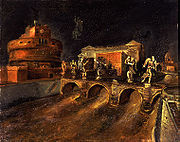
Scipione (Gino Bonichi)
Encyclopedia

Italy
Italy , officially the Italian Republic languages]] under the European Charter for Regional or Minority Languages. In each of these, Italy's official name is as follows:;;;;;;;;), is a unitary parliamentary republic in South-Central Europe. To the north it borders France, Switzerland, Austria and...
painter and writer.
He was born in Macerata
Macerata
Macerata is a city and comune in central Italy, the capital of the province of Macerata in the Marche region.The historical city center is located on a hill between the Chienti and Potenza rivers. It consisted of the Picenes city named Ricina, then, after the romanization, Recina and Helvia Recina...
. In 1909 he moved to Rome, where he later enrolled at the Scuola Libera di Nudo of the Accademia di Belle Arti di Roma. He founded with Mario Mafai
Mario Mafai
Mario Mafai , was an Italian painter, founder with his wife Antonietta Raphaël of the modern art movement called Scuola Romana.- Biography :...
and Antonietta Raphael
Antonietta Raphael
Antonietta Raphaël , was an Italian sculptor and painter of Jewish heritage and Lithuanian birth, who founded the Scuola Romana movement together with her husband Mario Mafai. She was an artist characterised by a profound anti-academic conviction, also affirmed by her sculptures which, especially...
the Scuola romana
Scuola Romana
Scuola romana or Scuola di via Cavour was a 20th century art movement defined by a group of painters within Expressionism and active in Rome between 1928 and 1945, and with a second phase in the mid-1950s.-Birth of the Movement:...
, a group of artists active in Rome who were influenced by Expressionism
Expressionism
Expressionism was a modernist movement, initially in poetry and painting, originating in Germany at the beginning of the 20th century. Its typical trait is to present the world solely from a subjective perspective, distorting it radically for emotional effect in order to evoke moods or ideas...
, and opposed the officially approved art of the Fascist period. He exhibited his work for the first time in 1927. At about this time, he also began publishing his poetry and essays.
Scipione's interest in art history led him to study the Italian old masters, as well as El Greco
El Greco
El Greco was a painter, sculptor and architect of the Spanish Renaissance. "El Greco" was a nickname, a reference to his ethnic Greek origin, and the artist normally signed his paintings with his full birth name in Greek letters, Δομήνικος Θεοτοκόπουλος .El Greco was born on Crete, which was at...
and Goya. Expressionists such as Chaim Soutine
Chaim Soutine
Chaïm Soutine was a Jewish painter from Belarus. Soutine made a major contribution to the expressionist movement while living in Paris....
, James Ensor
James Ensor
James Sidney Edouard, Baron Ensor was a Flemish-Belgian painter and printmaker, an important influence on expressionism and surrealism who lived in Ostend for almost his entire life...
and George Grosz
George Grosz
Georg Ehrenfried Groß was a German artist known especially for his savagely caricatural drawings of Berlin life in the 1920s...
influenced the development of his style, which was characterized by mysticism and a personal symbolism. His period of greatest activity was between 1927 and the autumn of 1930; during these years he produced his most important works, such as Still-life with a Bowler Hat (1929) and Still-life with a Feather (1929). He exhibited in the Venice Biennale
Venice Biennale
The Venice Biennale is a major contemporary art exhibition that takes place once every two years in Venice, Italy. The Venice Film Festival is part of it. So too is the Venice Biennale of Architecture, which is held in even years...
in 1930, and at the first Rome Quadriennale
Rome Quadriennale
The Rome Quadriennale is a foundation for the promotion of contemporary Italian art....
in 1931. In the last two years of his life, the tuberculosis
Tuberculosis
Tuberculosis, MTB, or TB is a common, and in many cases lethal, infectious disease caused by various strains of mycobacteria, usually Mycobacterium tuberculosis. Tuberculosis usually attacks the lungs but can also affect other parts of the body...
from which he had suffered for years forced him to abandon painting in favor of drawing. He died in Arco on November 9, 1933.
The Italian painter Claudio Bonichi (born in 1943) is Scipione's nephew
Nephew
Nephew is a son of one's sibling or sibling-in-law, and niece is a daughter of one's sibling or a sibling-in-law. Sons and daughters of siblings-in-law are also informally referred to as nephews and nieces respectively, even though there is no blood relation...
.

